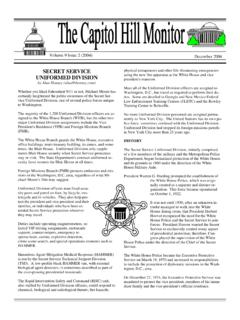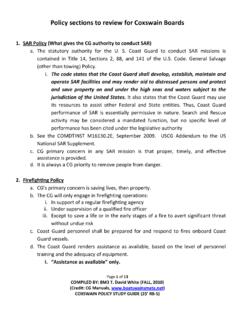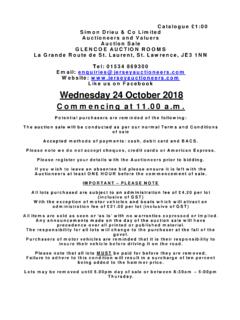Transcription of MARYLAND’S EMS CATEGORIES, Cate- PRIORITIES AND …
1 maryland S EMS categories , PRIORITIES AND GCS score Scanner listeners have been scratching their heads try-ing to make sense of maryland 's new trauma categories . The categories are frequently referenced by EMS pro-viders during radio transmissions to describe a patient s condition. The new category designations took effect July 1, 2008, but have received increased attention especially after the maryland State Police helicopter crashed on Sep-tember 28, 2008. To determine the category, a patient s condition is evaluated using a decision tree, which was revised in October. If the patient does not meet Category A status, the patient is evaluated in Category B, then C, and finally, Category D.
2 The Glasgow Coma Scale (GCS), which is referenced in Category A and B, is explained on page 2. A Category A trauma is the most severe and meets at least one of the following criteria: GCS less than or equal to 8 or Systolic BP less than 90 (Adult) or less than 60 (Child) or Respiratory rate less than 10 or greater than 29. Flail chest Rapidly declining GCS 2 or more proximal long- bone fractures Pelvic fracture Paralysis (spine) Penetrating injuries to head, neck, or torso Open or depressed skull fracture The Category A patient should be taken to a trauma center or specialty center per protocol. Helicopter trans-port should be considered if quicker and of clinical bene-fit.
3 Volume 14 Issue 2 (2009) The next most critical category is Category B. A Cate- gory B patient meets at least one of the following crite-ria: GCS 9 - 14 Paralysis or vascular compromise of limb Amputation proximal to wrist or ankle Crushed, degloved, or mangled extremity Penetrating injuries to extremities proximal to elbow or knee Combination trauma with burns The Category B patient should be taken to a trauma center or specialty center per protocol. Helicopter trans-port should be considered if quicker and of clinical bene-fit. The third most serious category is Category C. The pa-tient should be evaluated for evidence of mechanism of injury and high-energy impact, as well as for falls and in-juries from a blast or explosion.
4 High Risk Auto Crash: Intrusion greater than 12 inches occupant site; greater than 18 inches any site Ejection (partial or complete) from vehicle Death in same passenger compartment Vehicle telemetry data consistent with high risk of injury Rollover without restraint Auto v. pedestrian/bicyclist thrown, run over, or with significant (20 mph) impact Motorcycle crash greater than 20 mph Falls greater than 3 times patient s height Exposure to blast or explosion The Category C patient should be taken to a trauma center. Patients within a 30-minute drive time of the closest appropriate trauma/specialty center should go by ground unless there are extenuating circumstances.
5 Receiving trauma center medical consultation is re-quired when considering whether helicopter transport is of clinical benefit. March 2009 The Capitol Hill Monitor Page 2 The least severe and final category is Category D. To qualify for Category D status, the patient must meet one of the following conditions: Age less than 5 or greater than 55 Patient with bleeding disorder or patient on anticoagulants Dialysis patient Burns without trauma mechanism go to burn center Pregnancy greater than 20 weeks EMS provider judgment EMS workers should consider medical direction and transport the Category D patient to a trauma center.
6 Patients within a 30-minute drive time of the closest appropriate trauma/specialty center should go by ground unless there are extenuating circumstances. Helicopter transport should be considered if of clinical benefit. Receiving trauma center medical consulta-tion is required when considering whether helicopter transport is of clinical benefit. Clinical Priority Levels Still used, often in conjunction with the above trauma categories , is the clinical priority level, 1 through 4. This is how MIEMSS defines those PRIORITIES : Priority 1 Critically ill or injured person requiring immediate attention; unstable patients with potentially life-threatening injury or illness.
7 Priority 2 Less serious condition, requiring emer-gency medical attention but not immediately endan-gering the patient s life. Priority 3 Non-emergent condition, requiring medi-cal attention but not on an emergency basis. Priority 4 Does not require medical attention. Glasgow Coma Scale (GCS) Glasgow Coma Scale, or GCS, is another technique for qualifying a patient s condition. In the GCS a pa-tient is evaluated based on three categories : eye opening, motor response and verbal response. The patient receives a score in each of the three catego-ries which is totaled for the GCS score . Three is the worst and 15 is the least severe.
8 Glasgow Coma Scale (GCS) Eye Opening 4 Spontaneously 3 To Voice 2 To Pain 1 No Response Motor Response 6 To Verbal Command - Obeys 5 To Painful Stimulus - Localizes Pain 4 Flexion - Withdraw 3 Flexion - Abnormal 2 Extension 1 No Response Verbal Response (age: greater than 5 years old) 5 Oriented and Converses 4 Disoriented and Converses 3 Inappropriate Words 2 Incomprehensible Sounds 1 No Response Glasgow Coma score Total (range is 3 to 15) For more information see the MIEMSS 2008 maryland Medical Protocols at: # # # SCANNING COAST GUARD SECTOR BALTIMORE By Ron Perron (Rapbep at aol dot com) The following technical data on the United States Coast Guard (CG) Sector Baltimore is derived from personal monitoring from my location just outside of Baltimore, maryland .
9 As stated on the official CG Website, the mission of CG Sector Baltimore is to effectively and effi-ciently: Maximize unit readiness, Prevent or respond to incidents, Understand and address our customers needs, Achieve unity of effort with our partners in order to provide maritime safety, security, accessibility, and environmental protection for the National Capital Region, and the upper Chesapeake Bay and its tributaries. CG Sector Baltimore and its subordinate units include Aids-to-Navigation Teams in Baltimore; Crisfield; and Potomac. There are Small Boat Stations in Annapolis; Crisfield; Curtis Bay; Oxford; St.
10 Inigoes; Stillpond; and Washington (Bolling AFB). The Capitol Hill Monitor Page 3 CG Station Curtis Bay, in addition to being an active Small Boat Sta-tion, also houses the Coast Guard's main shipyard which per-forms maintenance, upgrades and new boat building for the entire Coast Guard fleet. Due to the ship-yard, there's usually an interesting "flow" of out-of-area vessels show-ing up on the marine channels. In communications I regularly hear CG Sector Balti-more, CG Station Curtis Bay, and CG Station Annapolis. The CG Sector Baltimore also is assisted by several area CG Auxiliary aircraft which provide airborne patrols of the Chesapeake Bay area during peak activity times, normally April through October.




